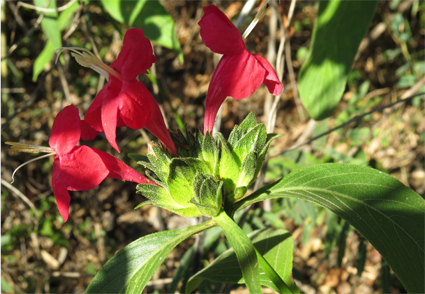Abstract
The name Ruellia capitata (Acanthaceae) given by Rizzini to the Brazilian species of the genus Ruellia, is an illegitimate name, as it is a later homonym of R. capitata described by D. Don based on specimens from Nepal in Asia. Therefore a new name, Ruellia scarlatina is proposed here for R. capitata. The detail description along with illustration, distribution map, conservation status, and morphological relationships, are provided. A key for the species of Ruellia with red flowers occurring in Goiás State, as well as coloured photographs of some of them, are also provided.
References
Bachman, S., Moat, J., Hill, A.W., de la Torre, J. & Scott, B. (2011) Supporting Red List threat assessments with GeoCAT: geospatial conservation assessment tool. ZooKeys 150: 117–126. https://doi.org/10.3897/zookeys.150.2109
Chagas, E.C.O. & Lima, J.L.C. (2020) Five new species of Ruellia (Acanthaceae) from the Atlantic Forest of northeastern Brazil. Neodiversity 13: 39–55. https://doi.org/10.13102/neod.131.2
Clarke, C.B. (1885) Acanthaceae. In: Hooker, J.D. (Ed.) The Flora of British India 4. Reeve & Co, London, pp. 387–558.
Don, D. (1825) Prodromus Florae Nepalensis. Veneunt apud J.Gale, London, 256 pp.
Ezcurra, C. (1989) Ruellia sanguinea (Acanthaceae) y especies relacionadas en Argentina, Uruguay y sur de Brasil. Darwiniana 29: 269–287. https://doi.org/10.2307/2807445
Ezcurra, C. (1993) Systematics of Ruellia (Acanthaceae) in southern South America. Annals of the Missouri Botanical Garden 80: 787–845. https://doi.org/10.2307/2399931
Ezcurra, C. (1998) A new species of Ruellia (Acanthaceae) from Paraguay. Brittonia 50: 339–342. https://doi.org/10.2307/2807777
Fernandes, U.G., Kameyama, C., Ezcurra, C., Indriunas, A. & Pessoa, C.S. (2020) Ruellia. In: Flora do Brasil 2020. Jardim Botânico do Rio de Janeiro. Available from: http://floradobrasil.jbrj.gov.br/reflora/floradobrasil/FB4204 (Accessed 7 January 2022)
Grisebach, A.H.R. (1879) Symbolae ad Floram Argentinam. Abhandlungen der Königlichen Gesellschaft der Wissenschaftenzu Göttingen 24: 3–346.
Hieronymus, G.H.E. (1878) Symbolae ad floram Braziliae centralis cognoscendam. In: Vidensk abelige Meddelelserfra Dansk Naturhistorisk Foreningi Kjöbenhavn. pp. 104.
IUCN (2017) Guidelines for using the IUCN red list categories and criteria. Version 13. Prepared by the Standards and Petitions Subcommittee of the IUCN Species Survival Commission. IUCN, Gland and Cambridge. Available from: http://cmsdocs.s3.amazonaws.com/RedListGuidelines.pdf (accessed 21 January 2022)
JSTOR Global Plants (2021) JSTOR Global Plants. Available at: http://plants.jstor.org/ (accessed 10 January 2022).
Linnaeus, C. (1753) Species Plantarum 2. Impensis Laurentii Salvii, Stockholm, pp. 561–1200.
Lindau, G. (1895) Acanthaceae. In: Engler, A. & Prantl, K. (Eds.) Die Natirlichen Pflanzenfamilien 4 (3b). Wilhelm Engelmann, Leipzig, pp. 274–353.
Nees von Esenbeck, C.G.D (1832) Acanthaceae Indiae Orientalis. In: Wallich, N. Plantae Asiatica Rariores, Treuttel, Würtz & Ritter, London, pp. 70–117.
Nees von Esenbeck, C.G.D (1847) Acanthaceae. In: von Martius, C.F.P., Eichler, A.G. & Urban, I. (Eds.) Flora Brasiliensis 9. Typographia Regia, Monachii, pp. 1–164, t. 1–31.
Pessôa, C.S. (2012) Ruellia L. (Acanthaceae) no estado de Minas Gerais, Brasil. Master’sdissertation. Universidade Federal de Viçosa, Minas Gerais, 78 pp.
Pohl, J.B.E. (1831) Plantarum Brasiliae icones et descriptiones hactenus ineditae 2. Antonii Strauss, Vienna, 152 pp.
Poiret, J.L.M. (1816) Encyclopeìdie meìthodique. Botanique, Suppl. 4. Agasse, Paris, 731 pp.
QGIS Development Team (2016) QGIS 2.14.19 Brighton software. Geographic Information System. OpenSource Geospatial Foundation Project. Available at: http://doc.qgis.org (accessed 11 January 2022).
Reis, A.S., Kameyama, C. & Gil, A.S.B. (2017) Ruellia anamariae, a new species of Acanthaceae from northern Brazil. Phytotaxa 327: 276–282. https://doi.org/10.11646/phytotaxa.327.3.7
Rizzini, C.T. (1956) Notulae de Acanthaceis novis seu minus cognitis. Dusenia 7: 299–305.
Schmidt-Lebuhn, A.N. & Tripp, E.A. (2009) Ruellia saccata, a new species of Acanthaceae from Bolivia. Novon 19: 515–519. https://doi.org/10.3417/2008021
Silva, M.G. (2011) Estudo Taxonômico da subtribo Ruelliinae Nees (Acanthaceae) no estado do Paraná, Brasil. Master’s dissertation. Universidade Federal do Paraná, Paraná, 76 pp.
Thiers B (2022 [continuously updated]) Index Herbariorum: A global directory of public herbaria and associated staff. New York Botanical Garden’s Virtual Herbarium. Available from: http://sweetgum.nybg.org/ih/ (accessed 5 January 2021)
Turland, N.J., Wiersema, J.H., Barrie, F.R., Greuter, W., Hawksworth, D.L., Herendeen, P.S., Knapp, S., Kusber, W.H., Li, D.Z., Marhold, K., May, T.W., McNeill, J., Monro, A.M., Prado, J., Price, M.J. & Smith, G.F. (Eds.) (2018) International Code of Nomenclature for algae, fungi, and plants (Shenzhen Code) adopted by the Nineteenth International Botanical Congress Shenzhen, China, July 2017. Regnum Vegetabile 159. Glashütten: Koeltz Botanical Books, 254 pp. https://doi.org/10.12705/Code.2018
Tripp, E.A. (2007) Evolutionary relationships within the species-rich genus Ruellia (Acanthaceae). Systematic Botany 32: 628–649. https://doi.org/10.1600/036364407782250625
Tripp, E.A. & Manos, P.S. (2008) Is floral specialization an evolutionary dead-end? Pollination system evolution in Ruellia (Acanthaceae). Evolution 62: 1712–1737. https://doi.org/10.1111/j.1558-5646.2008.00398.x
Vilar, T.S. (2009) Acanthaceae Juss. no Distrito Federal, Brasil. Master’s dissertation. Universidade de Brasília, Distrito Federal, 120 pp.
Wallich, N. (1830) A numerical list of dried specimens (Wallich’s Catalogue). East India Company Museum, London, 306 pp.
Wasshausen, D.C. & Wood, J.R.I. (2003) Notes on the genus Ruellia (Acanthaceae) in Bolivia, Peru and Brazil. Proceedings of the Biological Society of Washington 116: 264–274
Wasshausen, D.C. & Smith, L.B. (1969) Acantáceas. In: Reitz, R. (ed.) Flora Ilustrada Catarinense. ACAN, Herbário Barbosa Rodrigues, Itajaí. pp. 1–134.


